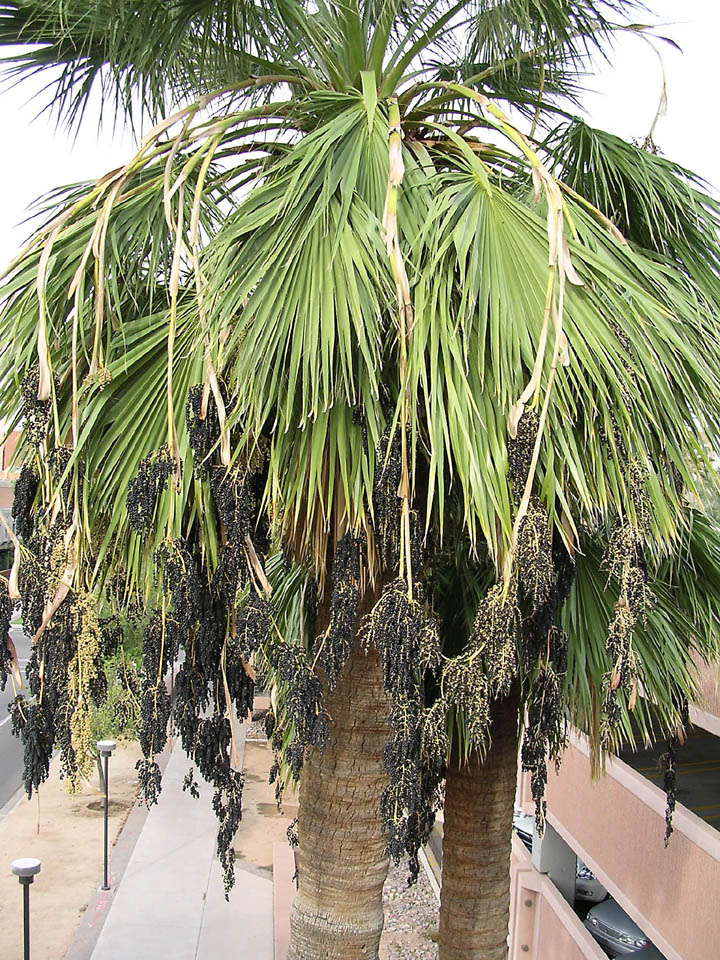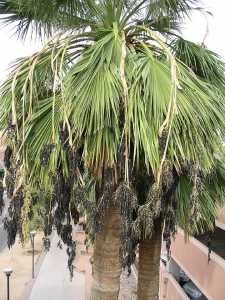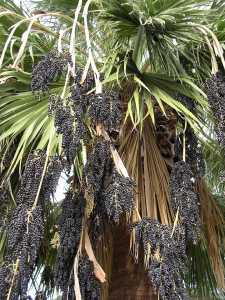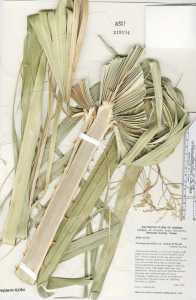Stems massive, to 1.5 m 100--150 cm diam. 2n = 36.
Flowering spring--summer. Native to desert washes, seeps, and springs where underground water is continuously available; of conservation concern; 100--1200 m; Ariz., Calif., Nev.; Mexico (Baja California).
L. H. Bailey (1936) cited S. Watson, not H. Wendland, as the combining authority of this species, believing that Wendland did not explicitly make the new combination. The combination was made, however, by the journal editor, Anton de Bary, in the index to the volume, appearing on page (column) LXI. Hence, de Bary, not Watson, is the combining author (J. L. Strother, pers. cComm.).
Naturalized populations of this species were reported at four sites in Nevada (J. W. Cornett 1987) and in Death Valley National Monument, California (J. W. Cornett 1988). L. R. McClenaghan and A. C. Beauchamp (1986) found low genetic variation among populations of Washingtonia filifera. V. J. Miller (1983) discussed the history and setting of W. filifera in Arizona.
PLANT: Trees to 15 m tall, the trunk to 1 m in diam.
LEAVES: with filiferous segments; petioles bearing marginal curved or hooked spines, these prominent at the base but reduced apically.
FLOWERS: 8-10 mm long.
FRUITS: 7-10 mm long.
NOTES: See also parent taxon for further description. Restricted to springs and seep areas of canyons: Kofa Mts., Yuma Co., and Alkali Springs, Yavapai Co.; 650-850 m (2000-2800 ft); Jun; CA; Baja C., Son., Mex. This species is widely planted from CA to FL as an ornamental tree.
REFERENCES: Mason, Charles T., Jr. 1999. Arecaceae. Ariz.-Nev. Acad. Sci. 32(1).
Common Name: California fan palm
Duration: Perennial
Nativity: Native
Lifeform: Tree
Wetland Status: FACW
Leaves: Petiole green, sharply toothed at base; blades gray-green, 1.5-2 m long, palmately divided nearly to middle with 40-60 segments, each with thread-like fibers on the margins.
Flowers: Pendant panicles to 5 m long, beginning within crown and dangling below the live leaves; flowers bisexual; calyx 3-lobed, the lobes more or less erect; corolla 3-lobed, the lobes white, reflexed.
Fruits: Drupes black, oblong or ovate, more or less fleshy.
Ecology: Found in groves, moist places, seeps, springs, and streamsides, below 4,000 ft (1219 m).
Distribution: s CA to s AZ; south to n MEX (Baja California)
Notes: This species is native to southern California and extreme western Arizona. It is also cultivated worldwide in tropical regions. W. robusta is another palm tree native to southern California and widespread in cultivation; it is distinguished by its more slender trunk which tapers in from a swollen base; and bright green leaves which form a compact crown and have few or no thread-like fibers on the margins (W. filifera has gray-green leaves with many marginal fibers and a loose, open crown).
Ethnobotany: Fruits and seeds used for food; fronds used as building material; also a cultivated ornamental.
Etymology: Washingtonia honors the first US president George Washington (1732-1799); filifera means thread-like and refers to the many thread-like fibers on the leaf margins.
Synonyms: Numerous, see Tropicos
Editor: AHazelton 2015










